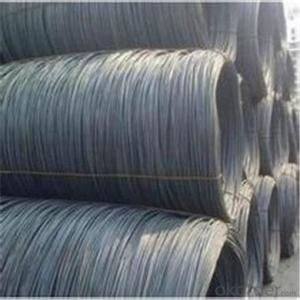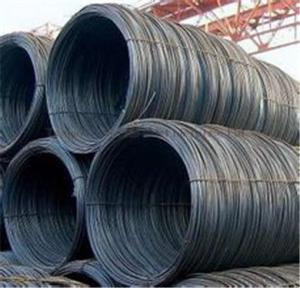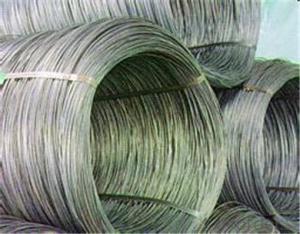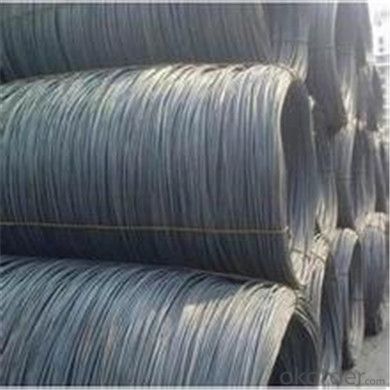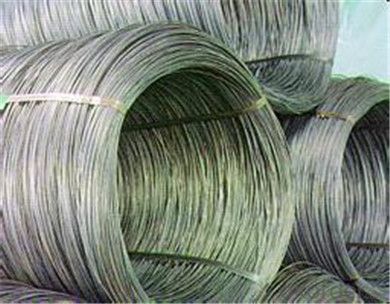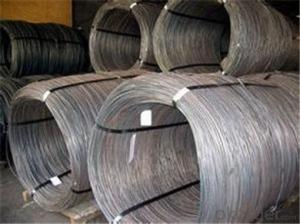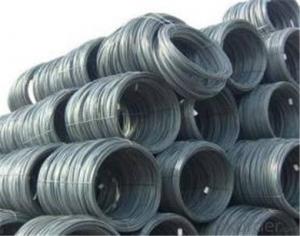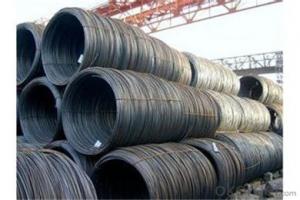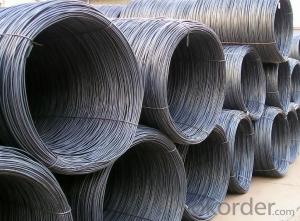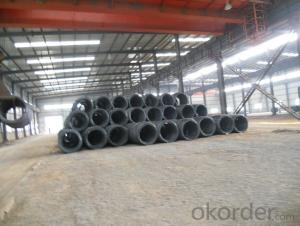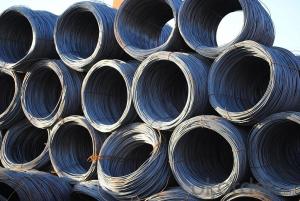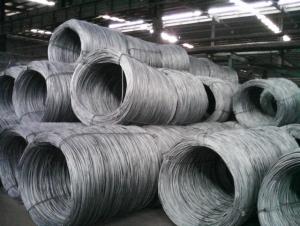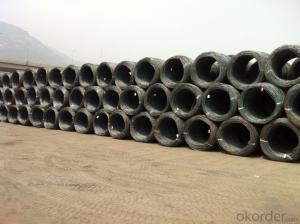SAE1008 Steel Wire rod 6.5mm with Best Quality
- Loading Port:
- Tianjin
- Payment Terms:
- TT OR LC
- Min Order Qty:
- 99 m.t.
- Supply Capability:
- 45555555 m.t./month
OKorder Service Pledge
OKorder Financial Service
You Might Also Like
Specification
Description of wire Rod:
wire rod:
Grade:SAE1006B/SAE1008B/SAE1018B
Size:5.5/6.5/7/8/9/10/11/12mm
Festures of wire Rod:
· fasteners, bolts, rivets, screws,
· general purpose wires,
· electrode wires, industrial wires, agriculture wires,
· bush wires, chain rivet wires,
· detonator wire,
· Umbrella ribs, upholstery wires, cycle spokes, needle wires, heald wires, staple pin Wire, safety pin wires
· ACSR wires, earth wires,
· tyre and hose reinforcement wires
· prestressed concrete wire, springs and rope wires,
· card clothing wires,
· vineyard wires,
Specifications of wire Rod:
Grade | Chemical Composition(%) | |||||
C | Mn | Si | S | P | Cr | |
SAE1006B | 0.03~O.07 | ≤0.32 | ≤0.30 | ≤0.045 | ≤0.040 | 0.3-0.35 |
Mechanical properties | ||||||
Yield strength(N/mm2) | Tensile strength(N/mm2) | Elongation(%) | ||||
250-280 | 350-380 | ≥32 | ||||
Grade | Chemical Composition(%) | |||||
C | Mn | Si | S | P | Cr | |
SAE1008B | 0.10max | 0.3~O.50 | 0.15max | 0.050max | 0.040 max | 0.3-0.35 |
Mechanical properties | ||||||
Yield strength(N/mm2) | Tensile strength(N/mm2) | Elongation(%) | ||||
≥195 | 315-430 | ≥30 | ||||
Images of wire Rod:
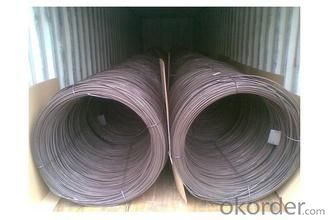
FAQ:
1. What is your package?
Packing situation: standard seaworthy packing or as customer required.
2. How long is the lead time?
Delivery time: 45 days after order confirmed.
3. What payment term do you accept?
Payment: T/T or L/C at sight.
- Q: How is steel wire rod used in the manufacturing of wire for elevator counterweights?
- Steel wire rod is an essential component in the manufacturing of wire for elevator counterweights. The process begins with high-quality steel wire rods, which are typically made from carbon or alloy steel. These rods are subjected to a series of manufacturing processes to transform them into wire that meets the specific requirements for elevator counterweights. Firstly, the steel wire rods are cleaned and descaled to remove any impurities or surface contaminants. This ensures that the wire produced is of the highest quality and has excellent corrosion resistance. Next, the rods go through the process of drawing, where they are pulled through a series of dies to reduce their diameter and increase their length. This process imparts the desired tensile strength and flexibility to the wire. After the drawing process, the wire is usually annealed to relieve any internal stresses and enhance its ductility. This involves heating the wire to a specific temperature and then slowly cooling it. Annealing not only improves the mechanical properties of the wire but also enhances its resistance to fatigue and wear. Once the wire has been drawn and annealed, it undergoes surface treatment processes such as coating or galvanizing. Coating the wire with a protective layer, such as zinc or epoxy, helps to prevent corrosion and extend its lifespan. Galvanizing involves dipping the wire into a bath of molten zinc to create a protective zinc coating, which provides excellent corrosion resistance. Finally, the coated or galvanized wire is further processed to achieve the desired shape and size for elevator counterweights. It can be cut into specific lengths or wound onto spools for easier handling during the manufacturing process. The wire is then used to form the internal structure of elevator counterweights, which are crucial for balancing the elevator car and ensuring its smooth operation. In summary, steel wire rods play a vital role in the manufacturing of wire for elevator counterweights. They are subjected to various processes, including cleaning, drawing, annealing, and surface treatment, to produce high-quality wire with the necessary strength, flexibility, and corrosion resistance. This wire is then used to construct the internal structure of elevator counterweights, ensuring the safe and efficient operation of elevators.
- Q: How is steel wire rod used in the manufacturing of wire baskets and containers?
- Steel wire rod is used in the manufacturing of wire baskets and containers as the primary raw material. It is first drawn through a series of dies to achieve the desired diameter and shape. This process strengthens the wire and improves its structural integrity. The wire rod is then bent, welded, or woven into the desired basket or container shape, providing a sturdy and durable framework. Additionally, the steel wire rod can be coated or galvanized to enhance its corrosion resistance, ensuring a longer lifespan for the wire baskets and containers.
- Q: What are the common production processes for xenon-coated steel wire rod?
- The common production processes for xenon-coated steel wire rod typically involve cleaning and pre-treating the steel wire rod, followed by applying a xenon coating using various methods such as physical vapor deposition or chemical vapor deposition. The coated wire rod is then subjected to curing or annealing processes to enhance the adhesion and durability of the xenon coating. Finally, the wire rod is further processed into desired shapes or sizes for specific applications.
- Q: What are the recent developments and innovations in steel wire rod production?
- Recent developments and innovations in steel wire rod production include the use of advanced technologies such as continuous casting and direct rolling, which improve the quality and efficiency of the production process. Additionally, there has been a focus on developing new alloys and coatings to enhance the strength, durability, and corrosion resistance of steel wire rods. Furthermore, automation and digitization have been introduced to optimize the production line, reduce energy consumption, and minimize waste. Overall, these advancements aim to meet the increasing demands of various industries and ensure the production of high-quality steel wire rods.
- Q: How is steel wire rod used in the production of wire for wire rope slings?
- Steel wire rod is a crucial component in the production of wire for wire rope slings. Wire rod is the raw material that is used to manufacture the wire ropes, which are then used in the production of wire rope slings. Wire rod is first processed through a series of manufacturing steps to transform it into wire ropes. These steps include drawing, stranding, and closing the wire ropes. The wire rod is initially drawn through a die to reduce its diameter and increase its length. This process helps to improve the strength and flexibility of the wire. After the drawing process, the wire rod is then stranded, which involves twisting multiple wires together to form a strand. Several strands are then twisted together to form the wire rope. This stranding process provides additional strength and durability to the wire rope, making it suitable for heavy-duty applications. Finally, the wire rope is closed by using specialized machinery to form a loop or an eye on one or both ends. This closure ensures that the wire rope can be securely attached to equipment or structures, allowing for safe lifting and handling. Overall, steel wire rod is an essential material in the production of wire for wire rope slings. It undergoes various manufacturing processes to transform it into wire ropes that possess high strength, flexibility, and durability. These wire ropes are then used in the construction of wire rope slings, which are widely employed in lifting and rigging operations across various industries.
- Q: How is steel wire rod used in the manufacturing of wire forms for bridge cables?
- Steel wire rod is a crucial component in the manufacturing of wire forms for bridge cables. It is primarily used as the raw material to produce the wire strands that make up the bridge cables. These wire strands are then twisted together to form the cables that provide the necessary strength and support for bridges. The steel wire rod goes through a series of processes to transform it into wire strands suitable for bridge cables. First, the rod is cleaned and descaled to remove any impurities and contaminants. It is then heated to a specific temperature and passed through a series of dies to reduce its diameter and increase its length. This process is known as wire drawing. After wire drawing, the steel wire rod is further processed through a stranding machine. Multiple wire strands are twisted together in a specific pattern to create a stronger and more durable cable. The twisting process ensures that the individual wire strands are tightly bound together, providing the necessary strength to withstand the load and tension experienced by bridge cables. The quality of the steel wire rod used in the manufacturing process is crucial to ensure the strength and performance of the bridge cables. It needs to have the right combination of tensile strength, ductility, and corrosion resistance. High-quality steel wire rod that meets specific standards and specifications is selected to ensure the reliability and longevity of the bridge cables. In conclusion, steel wire rod is a fundamental material used in the manufacturing of wire forms for bridge cables. It undergoes various processes, such as wire drawing and stranding, to create wire strands that are then twisted together to form the cables. The quality of the steel wire rod is essential to ensure the strength and durability of the bridge cables, making it a critical component in the construction and maintenance of bridges.
- Q: How is steel wire rod used in the manufacturing of wire forms for elevator shafts?
- Steel wire rod is an essential component in the manufacturing of wire forms for elevator shafts. Elevator shafts require strong and durable materials to ensure the safety and reliability of the elevator system. Steel wire rod, which is a long cylindrical steel product, is commonly used in this process due to its inherent strength and flexibility. Firstly, steel wire rod is used as the primary raw material for manufacturing wire forms for elevator shafts. The wire rod undergoes several processes, including drawing, annealing, and surface treatment, to enhance its mechanical properties and surface finish. These processes help to refine the steel wire rod and make it suitable for further manufacturing. Once the steel wire rod is prepared, it is formed into various wire shapes that are specifically designed for elevator shafts. These wire forms can include guide rails, safety ropes, suspension cables, and counterweight ropes, among others. Each wire form serves a crucial function in the elevator system, contributing to its smooth operation and ensuring the safety of passengers. The wire forms made from steel wire rod are known for their high tensile strength, which is essential for withstanding the heavy loads and constant movement experienced by elevator systems. The wires must be able to support the weight of the elevator car and its occupants while maintaining their structural integrity over time. Steel wire rod provides the necessary strength and durability to meet these requirements. Furthermore, steel wire rod offers excellent flexibility and elasticity, allowing the wire forms to withstand the dynamic movements of the elevator system. Elevators experience constant vertical and horizontal motions, as well as vibrations, which can put stress on the wire forms. Steel wire rod's flexibility helps to absorb and distribute these forces, reducing the risk of damage or failure. In addition to its mechanical properties, steel wire rod is also corrosion-resistant, providing long-lasting performance in elevator shafts. Elevator systems are often exposed to various environmental factors, such as humidity and temperature changes, which can cause corrosion and deterioration. By using steel wire rod, manufacturers can ensure that the wire forms will remain reliable and safe for an extended period. In conclusion, steel wire rod plays a vital role in the manufacturing of wire forms for elevator shafts. Its high tensile strength, flexibility, and corrosion resistance make it an ideal material for producing wire forms that can withstand the demanding conditions of elevator systems. By utilizing steel wire rod, manufacturers can create safe and durable wire forms that contribute to the smooth operation of elevators and the security of passengers.
- Q: How does the fatigue strength of steel wire rod vary with different wire drawing processes?
- The fatigue strength of steel wire rod can vary depending on the specific wire drawing process used. Wire drawing is a metalworking process that involves pulling a metal wire through a die to reduce its diameter and increase its length. There are various wire drawing processes, such as wet drawing, dry drawing, and intermediate drawing, each with unique characteristics and effects on the fatigue strength of the steel wire rod. One factor that affects the fatigue strength is the lubrication used during the wire drawing process. Wet drawing involves immersing the wire rod in a lubricant to reduce friction and heat generation. This lubrication helps in reducing the chances of surface defects and improves the fatigue strength of the wire rod. On the other hand, dry drawing does not involve any lubrication, which can result in increased friction and heat generation, potentially leading to a decrease in fatigue strength. The reduction ratio, which is the ratio of the initial wire diameter to the final wire diameter, also plays a crucial role. Higher reduction ratios can lead to an increase in the fatigue strength of the wire rod as the process aligns the grain structure and improves the overall mechanical properties. However, excessively high reduction ratios can introduce internal defects or residual stresses, which can negatively impact the fatigue strength. The heat treatment process after wire drawing can significantly influence the fatigue strength as well. Heat treatment techniques, such as annealing or quenching, can enhance the microstructure of the wire rod and improve its fatigue strength. Annealing helps in relieving internal stresses and refining the grain structure, while quenching provides increased hardness and strength. These heat treatment processes can compensate for any potential reduction in fatigue strength caused by the wire drawing process. In summary, the fatigue strength of steel wire rod can vary with different wire drawing processes. Factors such as lubrication, reduction ratio, and heat treatment techniques can all influence the fatigue strength. It is essential to carefully select the appropriate wire drawing process and associated parameters to optimize the fatigue strength of the steel wire rod for specific applications.
- Q: How is steel wire rod used in the manufacturing of wire forms for garage doors?
- Steel wire rod is used in the manufacturing of wire forms for garage doors as it provides strength, durability, and flexibility required for supporting and operating the door. The wire rod is first shaped and bent into various forms such as springs, cables, and hinges, which are essential components of a garage door system. These wire forms help in the smooth movement and proper functioning of the door, ensuring its stability and longevity.
- Q: What are the different types of steel wire rod surface defect prevention and control measures?
- There are several measures to prevent and control surface defects in steel wire rods. Some of these include proper cleaning and descaling processes before rolling, using high-quality raw materials, maintaining optimal rolling parameters, implementing effective cooling systems, and regularly inspecting and maintaining the rolling mill equipment. Additionally, employing advanced technologies such as electromagnetic stirring and lubrication systems can help minimize surface defects in steel wire rods.
Send your message to us
SAE1008 Steel Wire rod 6.5mm with Best Quality
- Loading Port:
- Tianjin
- Payment Terms:
- TT OR LC
- Min Order Qty:
- 99 m.t.
- Supply Capability:
- 45555555 m.t./month
OKorder Service Pledge
OKorder Financial Service
Similar products
Hot products
Hot Searches
Related keywords
